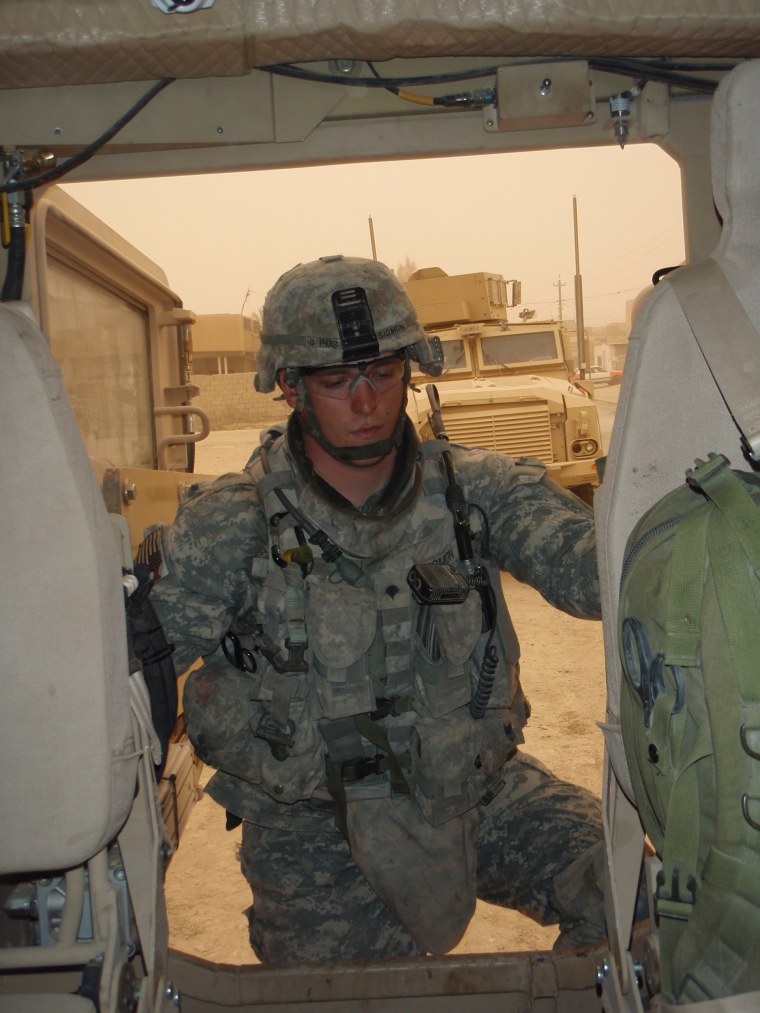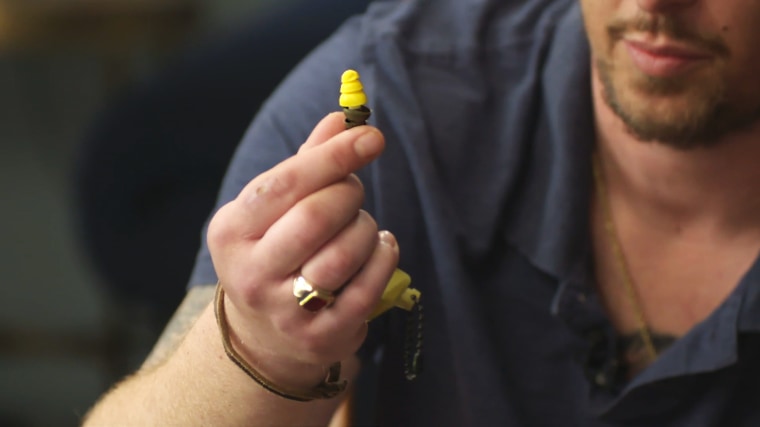Joseph Sigmon was sitting in his high school French class in 2001 when he watched on TV as a hijacked plane slammed into New York’s World Trade Center. His immediate thought, Sigmon told NBC News, was to join the military. “I just knew I needed to do my part,” Sigmon recalled.
For Sigmon, that meant completing two tours of duty in the U.S. Army as a field artillery specialist in Iraq and Afghanistan. He was decorated for his work training Afghan soldiers how to operate artillery, and upon discharge, Sigmon held the rank of staff sergeant, a U.S. Army spokesman confirmed.
While Sigmon did his part, the company that supplied the Army with earplugs to protect his hearing did not, he says. That company is 3M, the St. Paul, Minnesota-based technology and manufacturing giant that supplied a version of Combat Arms earplugs to the U.S. military from 2008 to 2015. Sigmon, 37, has been diagnosed with tinnitus, a persistent ringing in his ears; he is one of about 290,000 U.S. military active-duty service members and veterans suing 3M over hearing problems they contend resulted from use of the company’s earplugs.
“When I got back, when it was quiet, I noticed a low tone ringing in my ears all the time,” said Sigmon, who lives in Newton, North Carolina, with his wife and two young girls. “At the end of the day, your ears are still ringing, and when you wake up in the middle of the night, you’re aggravated because you can’t get it to quit.”

Since 2018, 3M has been battling lawsuits brought by service members like Sigmon. The company contends the earplugs provided effective protection when used properly and did not cause the hearing damage the plaintiffs have experienced. So far, 3M has lost cases brought by 12 service members and has prevailed against six.
The service members who won their cases against 3M in court have been awarded $220 million, including punitive damages. 3M has not paid these awards, as it is appealing the verdicts and asking the court to address what it calls “legal and evidentiary errors” presented at the trials.
After a trial scheduled to begin Monday in Florida, another 1,000 cases are in the pipeline.
The service member lawsuits followed a 2018 settlement 3M struck with the Justice Department, which alleged the company knowingly supplied the U.S. military with defective earplugs that were too short to fit all users properly. The government also contended that 3M failed to disclose the design defect to the military.
3M paid $9.1 million to settle the matter and did not admit wrongdoing.
Today, the Combat Arms suits make up one of the biggest multidistrict litigations in U.S. history. Fears about potential liabilities associated with the litigation continue to weigh on 3M stock, which had fallen 26 percent over the past year as of Friday. The company has set aside no reserves for those potential liabilities.
The company has argued that the service member cases should never have gone to trial and that the federal judge hearing them “wrongly rejected” 3M’s contention that any defects in the earplugs were based on a design mandated by the U.S. Army. The plaintiffs, however, contend the military did not provide design specifications for the earplugs, and 3M has conceded there was no traditional contract with the government.
Eric Rucker, 3M’s associate general counsel, is managing the litigation. In an interview with NBC News, Rucker said it is 3M’s position that the product works. “When a soldier is fitted with the Combat Arms Earplugs Version 2, and trained how to use it properly, and does use it, it will protect their hearing,” Rucker said.
A 3M spokesperson added that 3M has argued in court that the product “was safe and effective to use when properly fitted and that 3M provided instruction to the military on the proper fitting and use.”
‘We protect you’
Hearing problems — including the tinnitus Sigmon experiences — are the most pervasive service-connected disabilities among U.S. veterans, according to the U.S. Department of Veterans Affairs, given the noise associated with combat, training and other aspects of service jobs.
Fenja Mattson, an audiologist who evaluates patients with hearing problems, has worked with veterans for 25 years.
“Anything over 90 decibels is painful,” Mattson said, “and service members frequently experience decibel levels up to 150 decibels in training and combat.”
That’s why earplugs are ubiquitous in war zones around the world; they are as much a part of a service member’s protective gear as a helmet or flak jacket, veterans say.

Mattson is not involved in the 3M litigation but said her experience shows how hearing loss and tinnitus can damage veterans’ lives.
“They tried to adapt. They go back to work. They go back to their families, but there’s one slight difference: They’re not hearing,” Mattson said. “What does that do? It affects your ability to connect with your family. It affects your ability to enjoy things that you used to enjoy, like music, or watching TV, or listening to a conversation or a story that your family is telling you. Small things like that can happen, but they have a huge impact.”
3M vowed that its earplugs were up to this crucial job. The company’s tag line for the Combat Arms earplugs it sold to the U.S. military was “You protect us. We protect you.”
3M didn’t invent the Combat Arms earplugs; in 2008, it acquired the company that did, Aearo Technologies LLC, for $1.2 billion. Aearo, which made more than just earplugs, devised an initial version of the Combat Arms product in 1998. It had two sides: One end was supposed to provide total hearing protection, while the other end allowed a user to hear conversations nearby.
Court filings show that a military contractor responsible for reviewing hearing protection devices for the government asked Aearo if it could shorten the earplug by about a quarter of an inch, which the company did.
In early 2000, the documents show, Aearo tested the earplugs and found that they were too short to fit all users properly and could loosen in place. The company determined that manipulating the plugs could provide a good fit, the documents show; 3M said, “Aearo clearly communicated this issue to the military.” The company has made later versions, but the lawsuits involve the version known as CAEv2.
For their part, the plaintiffs point to a 2019 deposition produced in the litigation, in which a 3M division scientist who worked with the military on the earplugs said he had no “paper documentation” showing that the military was advised of the earplugs’ loosening problem.
A Pentagon spokesperson declined to comment on the earplugs, their design or training in their use, citing litigation.
Documents produced in the litigation show Combat Arms earplugs were highly profitable: The products cost around 85 cents a pair to make and sold for $7.63. “CAE pays the bills,” an executive wrote in an email produced in the litigation.
Rucker said that comment reflected all Combat Arms earplugs, not just those that are the subject of litigation, known as CAEv2. Asked about the profitability of the Combat Arms earplugs, Rucker said they “created the same margins as many other products.”
Among the more troubling exchanges to emerge from the litigation came in a 2020 deposition of Martin Salon, a former Aearo executive. In that deposition, Salon was asked if he thought it was OK “to sell a product and conceal information where it will have a negative effect on our soldiers?” He answered yes, court records show.
Voicemail and email messages seeking comment from Salon were not returned.
Asked about Salon’s testimony, 3M’s Rucker disputed that information was concealed about the product. Rucker also said of Salon that “there is testimony presented as part of that deposition at the trial that he suffered from a fairly significant medical condition, including a cardiac arrest in 2003, that significantly impacted his memory and ability to remember and talk about what happened while he was working at Aearo.”
One of 3M’s key arguments in the veteran litigation has been the “government contractor defense,” which it believes shields it from liability because the earplugs were developed to meet the “U.S. military’s request for a product that could meet specific and unique challenges faced by service members.”
The federal judge in Pensacola, Florida, who is presiding over the earplug cases rejected 3M’s argument that any defects in the earplugs were the result of a design required by the U.S. military. 3M says the judge, who is a veteran herself, erred in this decision and that if this issue was resolved in the company’s favor, many cases would be dismissed.

3M’s lawyers acknowledge that there was no traditional contract with the military for the Combat Arms earplugs. Instead, the company contends, if an agreement exists between the government and a manufacturer containing adequate specifics of what the military wants in a product, that is effectively a contract and the company should be protected from litigation under the government contractor defense.
Lawyers for plaintiffs dispute this interpretation. “3M had no contract with the government regarding the design of the earplug, which came into existence without any specifications from the military,” a statement from the court-appointed lawyers leading the case said. “We will continue to hold 3M fully accountable for putting profits over the safety of those who served our nation.”
‘You could feel the percussion’
During his deployments in Iraq in 2006 and Afghanistan in 2013, Sigmon said he recalls thinking that his earplugs might not be effective.
“I remember me and my buddies talking about the earplugs aren’t working,” he said. “When you would fire your rifle, you could still feel a pinprick in your ear. You could feel the percussion. You could feel that sharp pain — the crack from it.”
But, he said, everybody assumed the plugs worked. “We wrote it off to these earplugs were protecting us — that was what we were told,” Sigmon said.
After he returned home, his hearing problems began, he said; he was missing out on conversations with friends and family.
“I started asking friends, ‘Do you notice me not paying attention?’” Sigmon recalled. “People around me were frustrated because they thought I was ignoring them.”
Sigmon said he didn’t initially act on his problem. Then his daughter began insisting she accompany him to the Veterans Affairs hospital for doctor’s appointments, so she could tell them he couldn’t hear properly, he said.
Chris Seeger is a lawyer at Seeger Weiss who represents Sigmon and other veterans in cases against 3M’s earplugs.
“Joseph Sigmon did two tours of duty — almost two years,” Seeger said. “It’s a long time to be in a combat theater without really proper protection of any kind. I mean, we wouldn’t send them out without helmets or with helmets that didn’t work.”
Now, Sigmon said he is speaking out about his hearing problems to help other veterans who may have similar problems.
“In the Army, you’re taught to always take care of your battle buddies, and that’s what I want to do,” Sigmon said. “There’s a lot of us out there. I want to help spread the word. You’re entitled to a court case to see if they did you wrong.”







More Stories
Heart-healthy habits linked to longer life without chronic conditions
Hoda Kotb Returns To TODAY Show After Handling Daughter’s Health Matter
Exercise 1.5 times more effective than drugs for depression, anxiety